Cooking My Way Into the Kitchen
Two recipes for early summer evenings and a peek into my kitchen in Abruzzo

When we bought our little house in Penne, the seller offered to include all the furnishings in the deal and we happily accepted, as it meant we could start enjoying the place immediately.
This has naturally turned out to be a mixed blessing, the mixed part being that the house feels like we’re staying in an Air B&B. What’s more, the previous owner of the house was Swedish, which means everything, with the (possible) exception of a wooden wine cabinet tucked into an alcove, comes from IKEA—sofas and tables, lamps, beds, dressers, and the many, many candle holders, votives, and hurricanes lined up on the living room floor and tucked into wall niches throughout the house.
The ambience of Air B&B living is especially prevalent in the kitchen, where the dinner plates are dark brown and absurdly rectangular, the knives and pots are nearly weightless, and there are no pasta bowls.
Correction: There were no pasta bowls. The first thing I did when I arrived here last spring as owner was to walk down to la signora—the old woman who runs the little kitchenware store about 200 paces down the slope from our house. It is not a fancy shop; there’s no sign over the doorway, just a random display in the window and on the stoop of some of the items she carries. You won’t find Agnelli or Lagostina here, but you will find pizzelle irons, terracotta arrosticini holders, wooden pasta forks, aluminum lids, wash tubs and a whole lot more. The place is like the Room of Requirement; pretty much anything, from canning equipment to those old rubber hot water bottles, will appear amid the clutter as needed. And, indeed, resting on the floor along one wall, was stack of classic white ceramic pasta bowls. I bought eight. The other day I stopped by again to buy a nut cracker and a couple of wooden spoons—I’m gradually replacing the heinous plastic cooking utensils.
A larger overhaul of the kitchen will have to wait until more pressing projects are completed (renovating two bathrooms, pulling rusted iron bars off windows, and repainting the exterior, to name a couple). Besides, while I’m not in love with the kitchen—especially the wood veneer surface of the cabinets, which seems to absorb fingerprints permanently no matter how much you scrub—it is perfectly functional. Everything works—the fridge, the three burners, the oven, even the weird little microwave in the corner that looks like and old TV set. And I actually like the countertops, which are made out of some sort of composite and have a pleasing solidity about them, and the wide porcelain sink.
The kitchen’s biggest asset is that it opens onto a postage stamp terrace with views of the hills out to the Adriatic (if you follow my Instagam, I’ve been posting almost daily sunrises and dusk shots in my IG stories, along with food and other Abruzzo-related content).
Does it feel like my kitchen? Not quite, but each time I cook in it I get to know and like it a little better, a process I think of as cooking my way into the kitchen. I make dishes that my family and I know and love and I experiment with new recipes. And in spite of the paltry batterie de cuisine, I’ve managed to make some darned good food, though this is likely due to the quality of ingredients from the local market stands.
Do you have a process for turning a house into a home? I would love to hear your thoughts in the comments.
Below are two recipes I made this past week, both good for early summer evenings, when the air is still cool and breezy. At least that’s how it’s been here of late. Mornings heat up quickly, but by afternoon, clouds start rolling in from the mountains. and more often than not we get a shower or a thunderstorm, with quickly dropping temps. Although this pattern has put a dent in the number of steps I’m able to get in on any given day, it’s not unpleasant.
The first recipe is Minestra di riso e cicoria, an old-fashioned, gentle dish somewhere between a soup and a porridge, in which the chicory is first boiled, then sautéed, then mixed with cooked white rice. Signore Nevio, the same gentleman who showed us how to clean artichokes, was the one who suggested I make it after I asked him how he likes to prepare chicory.
Much like artichokes, chicory can be hard to find outside of Italy. Well, certain kinds of chicory. It’s a big category that includes, but is not limited to, Belgian endive, curly endive, escarole, and various types of radicchio.. The chicory pictured above, which is what I used to make my riso e circoria is Catalogna (Catalonia). A slightly different type of Catologna is used for puntarelle, those bitter white shoots that Romans adore, thinly sliced and tossed with anchovy dressing. Catalonia chicory is less bitter, but it does have an appealing edge. If you can’t find Catalonia chicory where you are, you can use escarole or even Swiss chard.
The other recipe is a Penne with Potatoes, Zucchini and Guanciale, a hearty pasta dish that I put together with ingredients that I had that needed to be used up. Still, I balk at calling this a “clean-out-the-fridge” recipe, a term that makes me wince because it conjures (in my mind, at least) a frenzy to toss in anything that might be about to turn or that has already turned. For obvious reasons I used penne pasta, but any good short, sturdy shape works.
Both recipes are new, meaning previously unpublished by me. Normally, new recipes are behind the paywall, but because there was no newsletter last week, I’m making them available to everyone.
For paid subscribers: I have another new recipe coming to you on Tuesday, one my daughter and I fell hard for a few weeks ago when our family had dinner at La Bilancia—the wonderful traditional Abruzzese restaurant in nearby Loreto Aprutino that was also the protagonist of my piece on Le Virtù. It’s cipollata, a silky onion stew which, when made with the right onions, verges on sweet. It’s fantastic with grilled lamb or sausages, or spooned onto good bread.
I’m also working on a couple of premium posts about places to visit here in Abruzzo. I’m still organizing my thoughts—there’s a lot to report on—but good stuff to come on that front.
RECIPE: Minestra di Riso e Cicoria
If you ever buy produce at a farmers’ market in Italy—or anywhere, I guess—be sure to ask the farmer or purveyor how they like to cook or serve it. This tactic has served me well. It was Signore Nevio—the same gentleman who demonstrated how to trim an artichoke—who suggested I use the head of chicory I bought to make riso e cicoria (rice and chicory). It requires a few steps, all of them easy, and it hits the spot on a cool evening in early summer.
As Nevio was explaining the process, a woman standing next to me chimed in that she likes to add a few spoonfuls of tomato passata to her riso e cicoria, a detail I have filed away for the next time I make this.
Makes 2 to 3 servings, and can easily be doubled
INGREDIENTS
1 bunch chicory, such as Catalogna; about 1 lb (454 g); or substitute escarole or Swiss chard
Sea salt
2 cloves garlic, lightly crushed
Extra-virgin olive oil
Peperoncino (chili pepper, either fresh or dried); optional
3/4 cup (150 g) Carnaroli rice
1 1/2 to 2 cups (355-470 ml) water
INSTRUCTIONS
1. Lop off the end of the chicory and separate the stalks; discard any that aren’t fresh. Wash well to remove any dirt and grit. If the stalks are especially long, cut them in half crosswise.
2. Put a pot of water on to boil and salt it (not too generously). Submerge the chicory—you may need to cut the stalks in half crosswise if they are too long. Once the water returns to a boil, cook for 5 to 8 minutes, until the stalks are wilted and just tender. Using tongs, transfer the chicory to a bowl to cool—no need to drain in a colander. When cool enough to handle, chop into bite-sized pieces.
3. Place the garlic and 4 to 5 tablespoons of olive oil in a skillet or sauté pan and set it over medium-low heat. Add the peperoncino, if using. Press down on the garlic with a wooden spoon to release its flavor and cook without letting it brown until it has begun to soften, about 5 minutes. Tip in the chicory and stir to coat it well with oil. Cook on medium heat—the chicory should sizzle just a bit—for about 5 minutes, turning it around in the oil with the spoon. Turn off the heat.
At this point, what you have is cicoria ripassata, or twice-cooked chicory, a classic spring side dish in Rome (Lazio, the region that contains Rome, and Abruzzo are neighbors so there is some overlap with regional dishes).
4. Cook the rice (you can do this while you’re also cooking the chicory since it’s a hands-off process). Bring 1 1/2 cups water to a boil in a saucepan and add a pinch of salt. Pour in the rice and bring to a boil over medium-high heat, stirring it once or twice. Lower the heat to maintain a bare simmer, cover, and cook until the rice is tender, about 20 minutes. It should be somewhat soupy at the end of cooking; if it’s too dense, add more water.
5. Pour the rice into the pan with the chicory, or vice versa; in any case, merge the two. Cook for a few minutes more, enough time to blend everything together nicely. Serve hot or warm and resist the urge to sprinkle cheese on top. But do drizzle good olive oil over each serving.
NOTE: For a slight variation, add a few spoonfuls of chopped tomatoes to the rice at the beginning of cooking.
RECIPE: Penne with Potatoes, Zucchini, and Guanciale
What I especially like about this combination: the mild-mannered zucchini takes on the flavor of the pork, and the potato soaks up the fat and juices, bringing everything together to make a rich sauce that cloaks the pasta. I used yellow potatoes from Avezzano, Abruzzo, also known as patate del Fucino, which are appreciated for their rich flavor verging on sweet and for their dense texture that lies somewhere between creamy and floury when cooked. This means that they can be employed in any number of ways in the kitchen: mashed, roasted, made into gnocchi, or cubed/mashed up and tossed with pasta, as I’ve done here. Any good yellow potato will do, as long as it’s not too waxy or watery.
Makes 3 to 4 first-course servings or 2 main-course servings
INGREDIENTS
1 medium-large yellow potato (100 g/3.5 oz), scrubbed
Sea salt
2 thickish slices guanciale (100 g/3.5 oz) cut into strips
Extra-virgin olive oil
2 small cloves garlic, lightly crushed
1/2 sweet red onion, cut into small dice
2 medium zucchini (300 g/10.5 oz), quartered lengthwise, then sliced crosswise into thin wedges
200 g penne rigate or other short, sturdy pasta
Freshly grated pecorino or Parmigiano-Reggiano cheese
INSTRUCTIONS
1. Put the potato in a saucepan and cover with cold water. Add 2 generous pinches of salt. Bring to a boil over medium-high heat, then lower the flame and boil gently until the potato is tender, 20 to 25 minutes. A cake tester or small knife blade should slide in and out easily. Drain out the water and let the potato cool.
2. Put the guanciale in a dry skillet and set it over medium heat. When the pieces begin to sizzle, turn the heat down to medium-low and cook until the guanciale has rendered several tablespoons of fat and turned crispy-tender. With a skimmer or slotted spoon, transfer the guanciale to a bowl and pour off all but 1 or 2 tablespoons of fat.
3. Add 1 to 2 tablespoons of olive oil to the pork fat in the pan and stir in the garlic, onion, and zucchini. Set over medium heat until the oil starts to sizzle, then lower the heat to medium-low and season with a small pinch of salt and a few grindings of black pepper. Cook for about 10 minutes, until the onion and zucchini have softened. Peel and cube the potato and add it to the skillet, mashing it up a bit with a wooden spoon. Cook gently until all the vegetables are soft and well combined, another 10 minutes or so.
4. Cook the pasta in a pot of boiling salted water until al dente. Using a skimmer or spider, transfer the pasta directly to the pan of vegetables, along with a ladleful or two of cooking water. Stir in the guanciale and toss everything together until well combined. Add a handful of cheese and toss again. Serve in shallow bowls, with a sprinkle of cheese on top.
PICTURE ITALY: Popoli (PE), 2023
Grazie—as always, thanks for reading, subscribing, and sharing.
Alla prossima,
Domenica

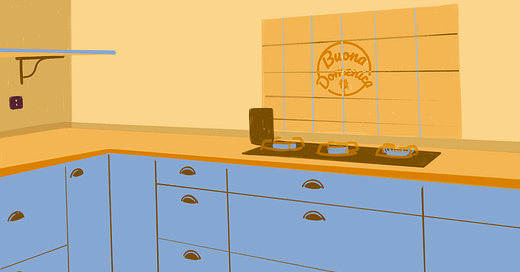


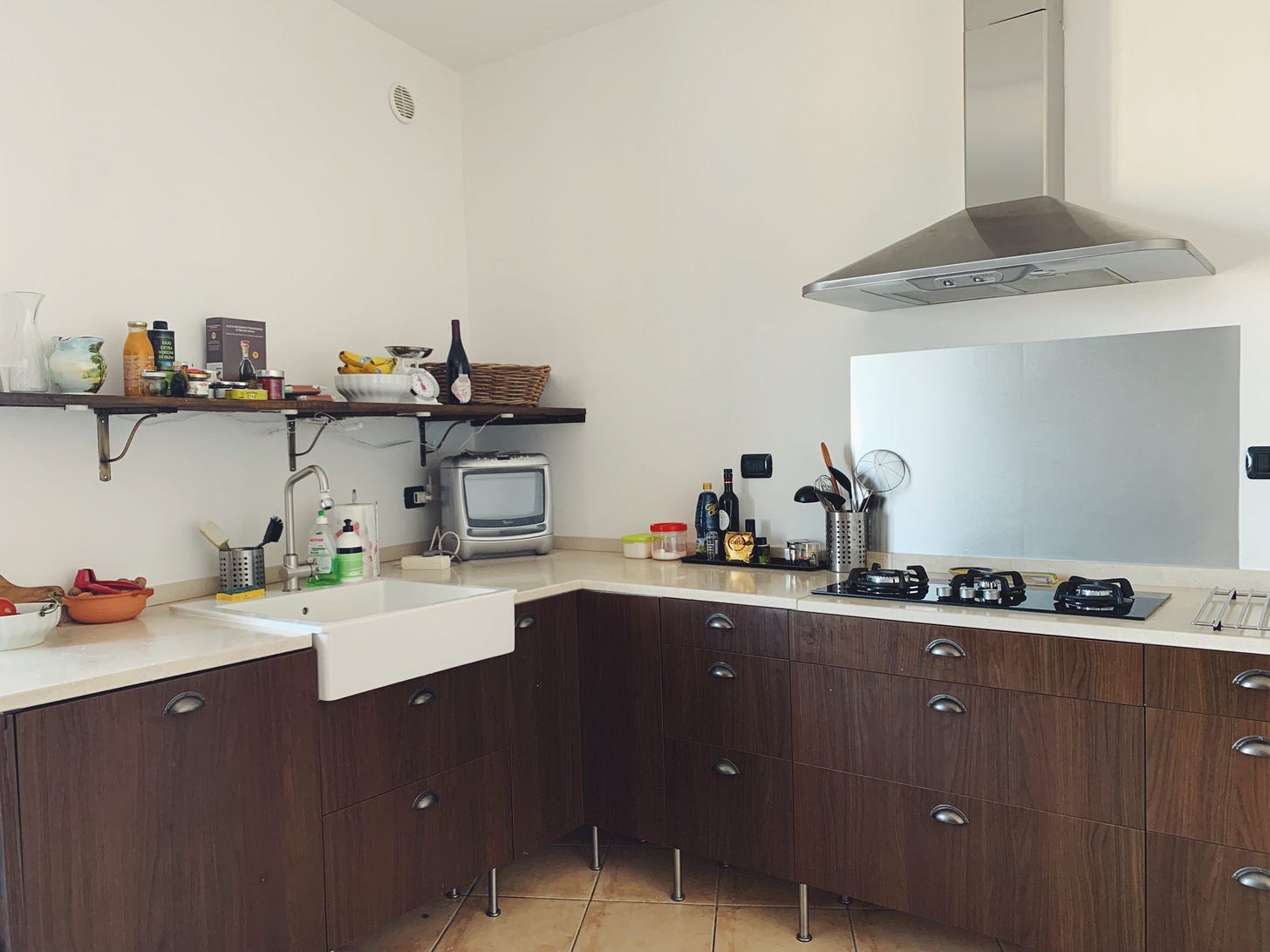
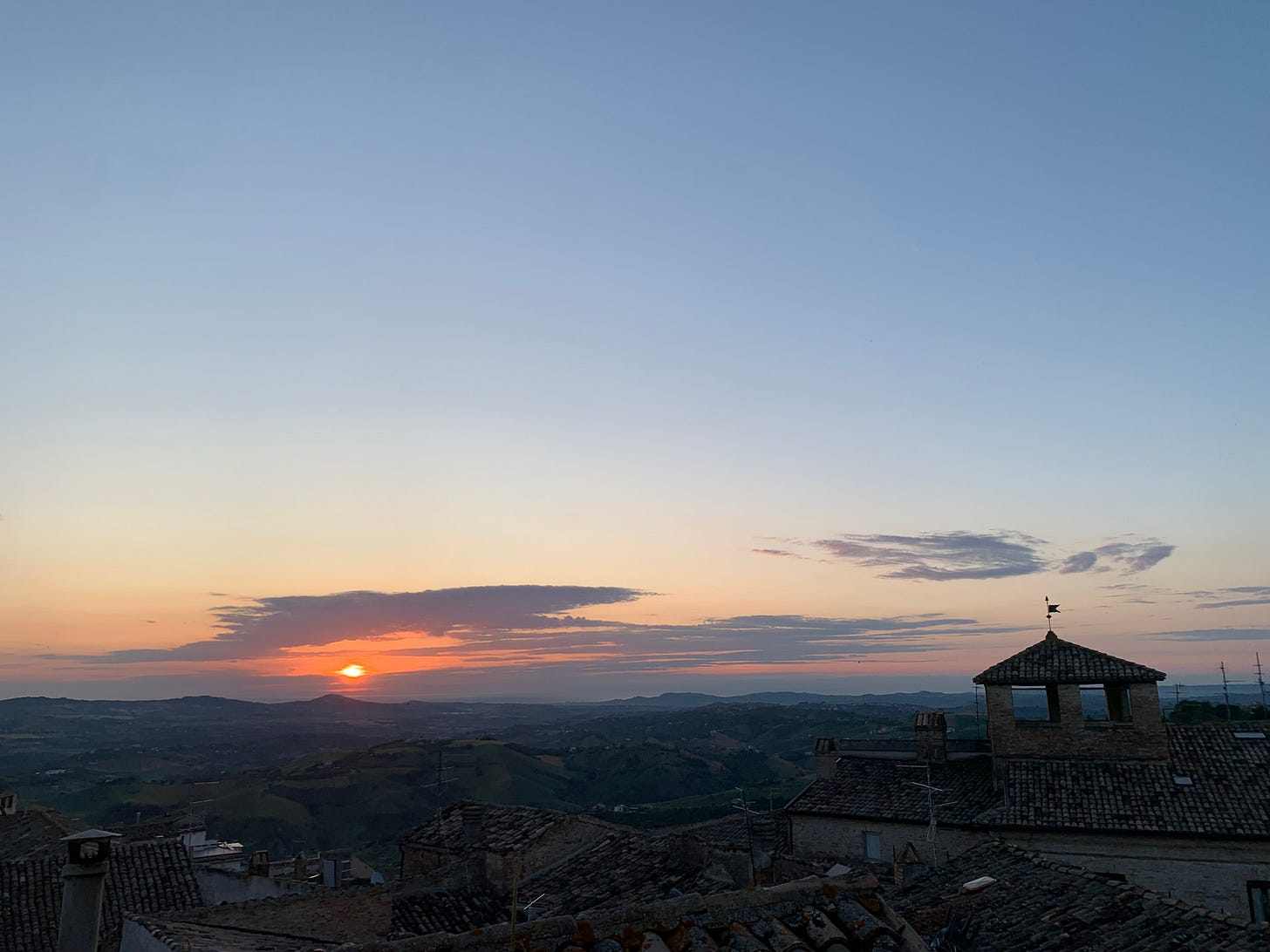
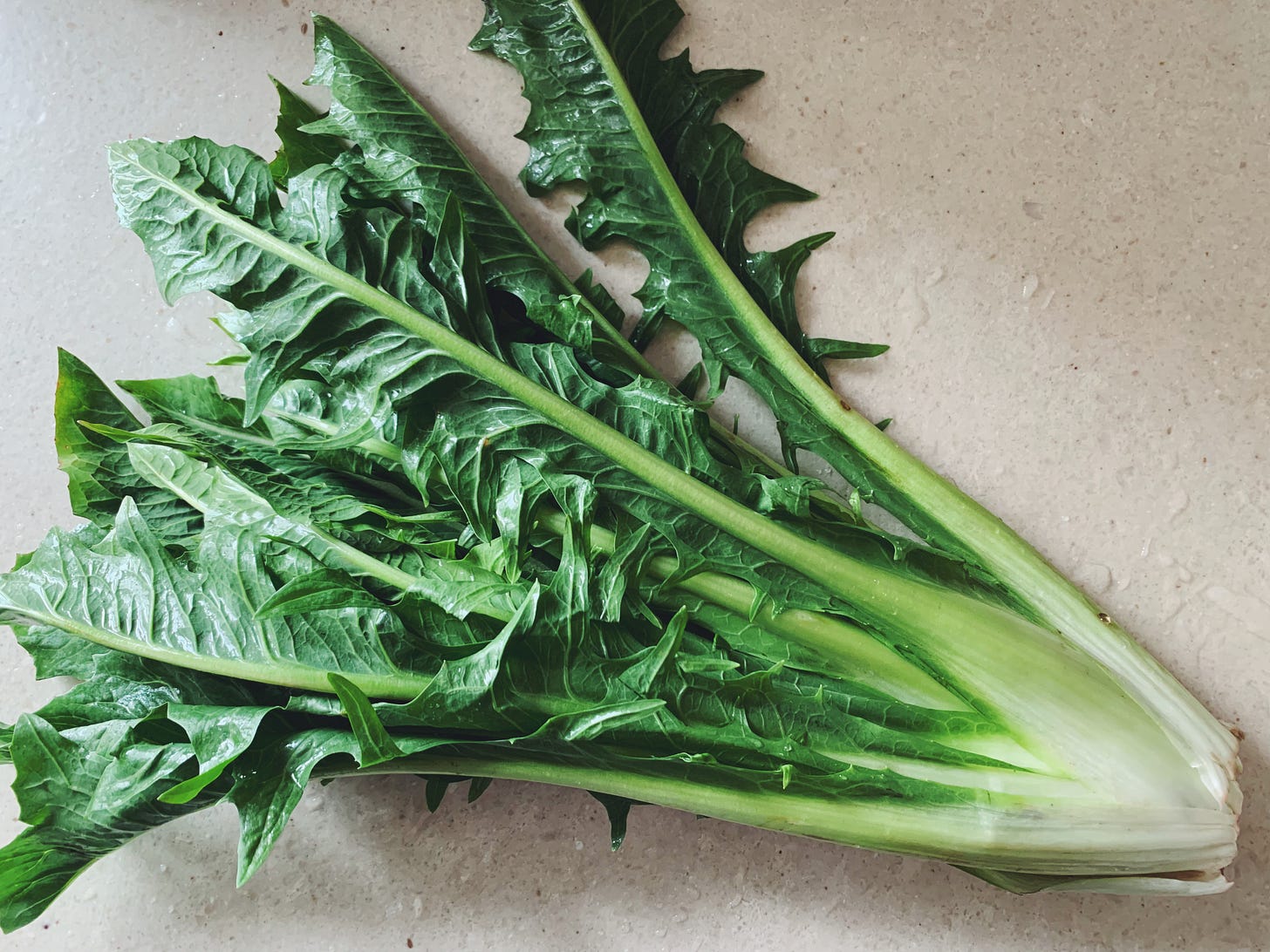
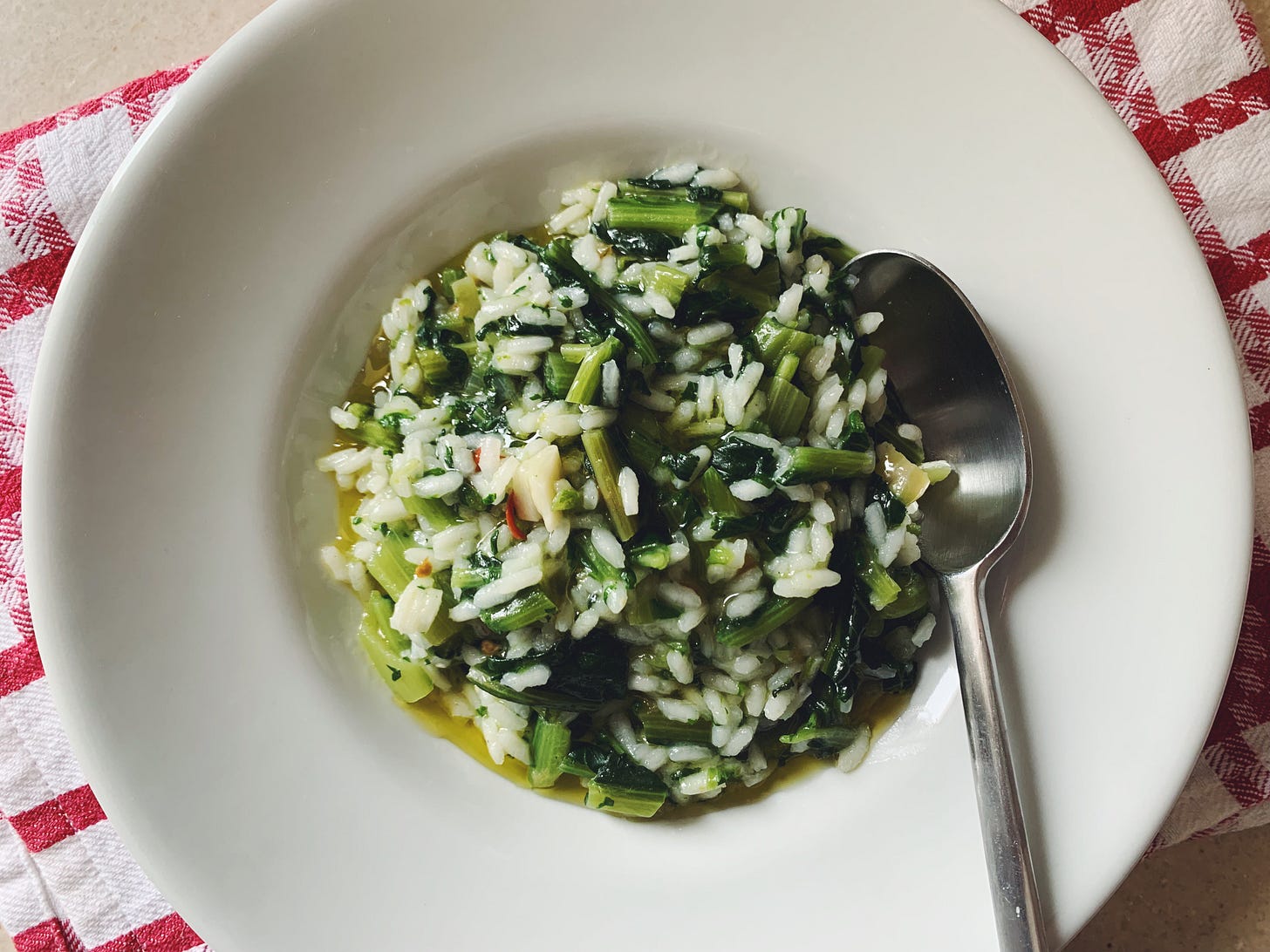
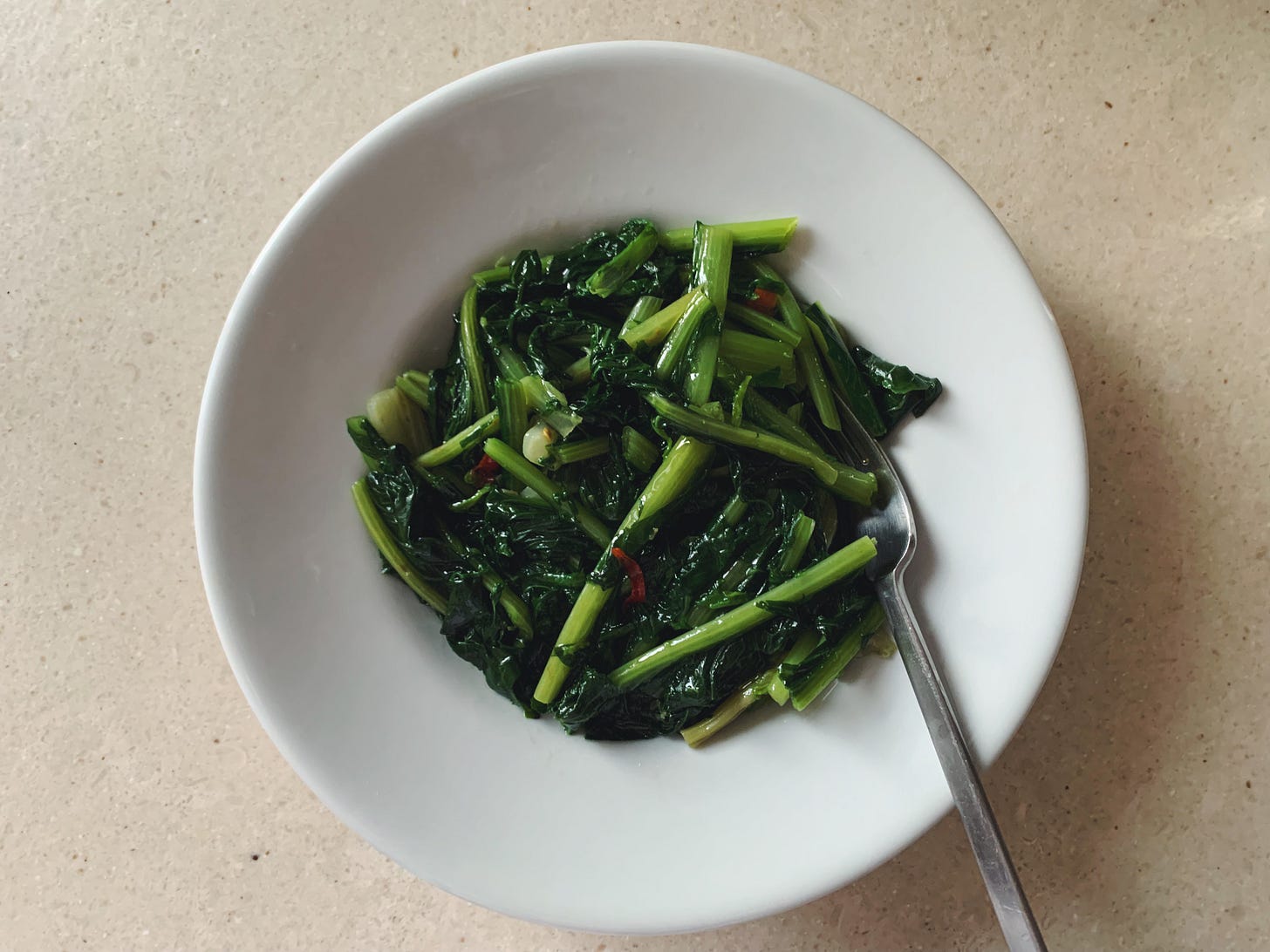
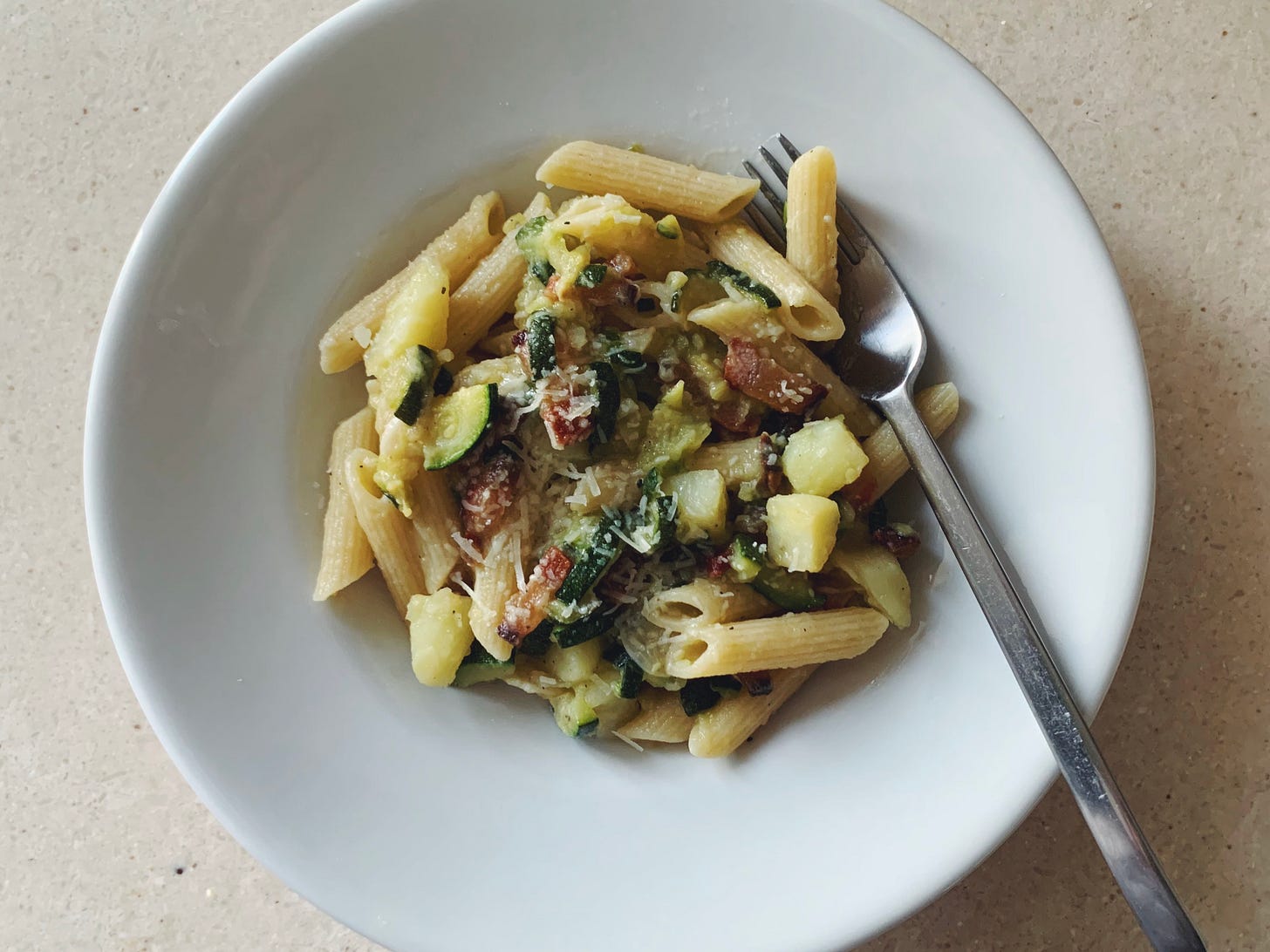

I love this idea! I am also going to keep the functional but zero aesthetic kitchen in my new Venetian house to give myself time to figure exactly what really works in the space. I have been cooking in temporary kitchens since March. I brought a few good knives, a tiny whisk, and spices. I miss my good pots SO very much.
I laughed when I read about the microwave-when I saw your post on Instagram I wondered if that was a small tv!